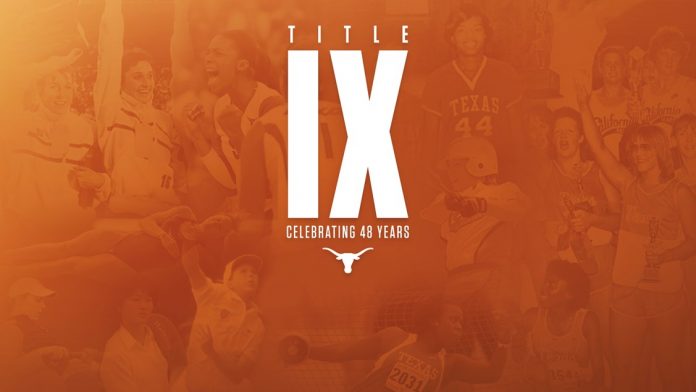Tuesday, June 23 marks the 48th anniversary of Title IX, when Congress proclaimed that “No person in the United States shall, on the basis of sex, be excluded from participation in, be denied the benefits of, or be subjected to discrimination under any education program or activity receiving Federal financial assistance.”
One of the greatest impacts Title IX has been in the area of women’s intercollegiate athletics. The University of Texas has long been a leader in women’s athletics.
UT sponsors 11 intercollegiate women’s athletics programs. Basketball, golf, swimming and diving, track & field/cross country, and volleyball all began with the 1974-75 school year. Women’s tennis was added in 1979, soccer in 1994 and softball in 1997. Rowing is the school’s most recent addition, beginning in 1998.
In those 11 sports, the Longhorns have captured 27 national titles and 96 Big 12 Conference Championships. Student-athletes have excelled in the classroom, in the community and on the professional and Olympic stages.
Growth throughout all levels of women’s athletics in the past 48 years is more than evident. Since that time, the number of girls participating in sports has increased from one in 27 to two in five.
Below is a history of Title IX, as provided by the Women’s Sports Foundation:
June 23, 1972
Title IX of the Education Amendments is enacted by Congress and is signed into law by Richard Nixon. The sponsors of Title IX are Birch Bayh (Senate) and Edith Green (House of Representatives). Title IX prohibits sex discrimination in any educational program or activity receiving any type of federal financial aid.
May 20, 1974
Senator Tower proposes the “Tower Amendment,” which would exempt revenue-producing sports from determinations of Title IX compliance. The amendment is rejected.
July 1974
In the spirit of Senator Tower’s failed amendment, Senator Javits submits an amendment directing HEW to issue regulations that provide for “reasonable provisions considering the nature of particular sports” (e.g., event-management needs, etc.) that clarifies that event and uniform expenditures on sports with larger crowds or more expensive equipment do not have to be matched in sports without similar needs.
May 27, 1975
President Ford signs the Title IX athletics regulations and submits them for congressional review (pursuant to Section 431(d)(1) of the General Education Provisions Act).
June 1975
Rep. O’Hara introduces House Bill 8394, which proposes that sports revenues first be used to offset the cost of that sport, and only then to support other sports. The proposed change would effectively alter Title IX’s coverage in athletics. This bill dies in committee before reaching the House floor.
July 21, 1975
Congress reviews and approves Title IX regulations and rejects the following resolutions advanced to disapprove the athletics regulations:
• June 4, 1975: Title IX was presented to Congress in its present form
• June 5, 1975, and June 17, 1975: Senator Helms (S. Con. Res. 46) and Rep. Martin (H. Con. Res. 310) condemn Title IX in its entirety
• June 17, 1975: Rep. Martin (H. Con. Res. 311) disapproves of Title IX only as it pertains to intercollegiate athletics
• July 16, 1975: Sens. Laxalt, Curtis and Fannin (S. Con. Res. 52) disapprove of the application of Title IX to intercollegiate athletics
• July 21, 1975: Sen. Helms introduces S. 2146 in an attempt to prohibit the application of Title IX regulations to athletics in situations in which participation in those athletic activities are not a required part of the institution’s curriculum (Sen. Helms re-introduced S. 2146 as S. 535 in 1977)
• Title IX federal regulations are issued in the area of athletics. High schools and colleges are given three years, and elementary schools one year, to comply.
February 17, 1976
NCAA challenges the legality of Title IX.
July 15, 1977
Senators Tower, Bartlett, and Hruska introduce Senate Bill (S. 2106), proposing to exclude revenue-producing sports from Title IX coverage. The bill dies in committee before reaching the Senate floor.
1978
HEW issues proposed policy “Title IX and Intercollegiate Athletics” for notice and comment.
July 21, 1978
Deadline for high schools and colleges to comply with Title IX athletics requirements.
December 11, 1979
HEW issues final policy interpretation on “Title IX and Intercollegiate Athletics.” Rather than relying exclusively on a presumption of compliance standard, the final policy focuses on each institution’s obligation to provide equal opportunity and details the factors to be considered in assessing actual compliance (Participation requirements are currently referred to as the “3-Prong-Test”).
1980
Department of Education is established and given oversight of Title IX through the Office for Civil Rights (OCR).
February 28, 1984
Grove City v. Bell limits the scope of Title IX, effectively taking away coverage of athletics except for athletic scholarships. The Supreme Court concludes that Title IX only applies to specific programs (i.e. Office of Student Financial Aid) that receive federal funds. Under this interpretation, athletic departments are not necessarily covered.
March 22, 1988
The Civil Rights Restoration Act of 1987 is enacted into law over the veto of President Ronald Reagan. This act reverses Grove City, restoring Title IX’s institution-wide coverage. If any program or activity in an educational institution receives federal funds, all of the institution’s programs and activities must comply with Title IX.
September 6, 1988
Haffer v. Temple University Title IX athletics lawsuit won by plaintiff female athletes gives new direction to athletic departments regarding their budgets, scholarships, and participation rates of male and female athletes.
April 2, 1990
Valerie M. Bonnette and Lamar Daniel author A Title IX Athletics Investigator’s Manual, issued by the Office for Civil Rights.4
February 26, 1992
In Franklin v. Gwinnett County Public Schools, the Supreme Court rules that monetary damages are available under Title IX. Previously, only injunctive relief was available (i.e., the institution would be enjoined from discriminating in the future).
1992
Shortly after the Franklin decision, the NCAA completes and publishes a landmark Gender-Equity Study of its member institutions.
1994
Sen. Mosley-Braun (S. 1468) and Rep. Collins (H.R. 921) sponsor the Equity in Athletics Disclosure Act (EADA), requiring that any co-educational institution of higher education that participates in any federal student financial aid program and that sponsors an intercollegiate athletics program must disclose certain information concerning its intercollegiate athletics program. Under the EADA, annual reports are required.
January 16, 1996
OCR issues a clarification of the three-part “Effective Accommodation Test” that reiterates the requirements of the policy interpretation that institutions may choose any one of three independent tests to demonstrate that they are effectively accommodating the participation needs of the underrepresented gender.
October 1, 1996
All institutions of higher education must make available, to all who inquire, specific information on their intercollegiate athletics department, as required by the Equity in Athletics Disclosure Act.6
November 21, 1996
A federal appeals court upholds a lower court’s ruling in Cohen v. Brown University, holding that Brown University illegally discriminated against female athletes. Brown argues that it did not violate Title IX because women are less interested in sports than men. Both the district court and the court of appeals rejects Brown’s argument. Many of the arguments offered by Brown are similar to those relied upon by colleges and universities all over the country.
June 23, 1997
Twenty-fifth anniversary of the passage of Title IX.
February 20, 2001
The Supreme Court issues a decision in Brentwood v. Tennessee Secondary School Athletic Association, holding that a high school athletic association is a “state actor” and thus subject to the Constitution. This means, for example, that the Equal Protection Clause of the 14th Amendment applies to athletic associations in gender equity suits.
December 17, 2001
Communities for Equity v. Michigan High School Athletic Association is decided, holding a state athletic association liable under Title IX, the Equal Protection Clause, and Michigan state law for discriminating against girls by forcing six girls’ sports, but no boys’ sports, teams to compete in nontraditional and/or disadvantageous seasons.
May 29, 2002
The U.S. Department of Justice (DOJ) filed a motion to dismiss on narrow procedural grounds a complaint filed in federal court against the U.S. Department of Education attacking the three-prong test developed for schools to determine their compliance with Title IX in women’s athletics programs.
June 23, 2002
Thirtieth anniversary of the passage of Title IX.
June 27, 2002
The U.S. Secretary of Education Rod Paige announced the establishment of a Commission on Opportunities in Athletics. The stated purpose of the Commission is “to collect information, analyze issues and obtain broad public input directed at improving the application of current Federal standards for measuring equal opportunity for men and women and boys and girls to participate in athletics under Title IX. The Commission will recommend to the Secretary, in a written report, whether those standards should be revised, and if so, how the standards should be revised. The Commission will also recommend other steps that might be taken to improve the effectiveness of Title IX and to maintain and build upon the extraordinary progress that has resulted from its passage 30 years ago.
July 11, 2003
The Office for Civil Rights of the United States Department of Education issued a “Further Clarification of Intercollegiate Athletics Policy Guidance Regarding Title IX Compliance.” The Further Clarification reaffirms the validity and effectiveness of long-standing administrative regulations and policies governing this application.
March 17, 2005
The Department of Education issued a policy guidance (“the Additional Clarification”) that significantly weakens Title IX. Schools can now simply send out an e-mail survey to their female students, asking them what additional sports they might have the interest and ability in playing. And if the survey responses do not show enough interest or ability, they do not have to add any sports – and are presumed in compliance with Title IX.
June 23, 2007
Thirty-fifth anniversary of the passage of Title IX.
April 20, 2010
The Department of Education issued a policy guidance which rescinded the aforementioned “Additional Clarification” and all related documents including the recommended survey.
April 4, 2011
The Department of Education issued a policy guidance which made clear that Title IX’s protections against sexual harassment and sexual violence apply to all students, including athletes. It addresses athletics departments in particular when it requires schools to use the same procedures that apply to all students to resolve sexual violence complaints involving student athletes.
June 23, 2012
Fortieth anniversary of the passage of Title IX.
June 23, 2017
Forty-fifth anniversary of the passage of Title IX.













